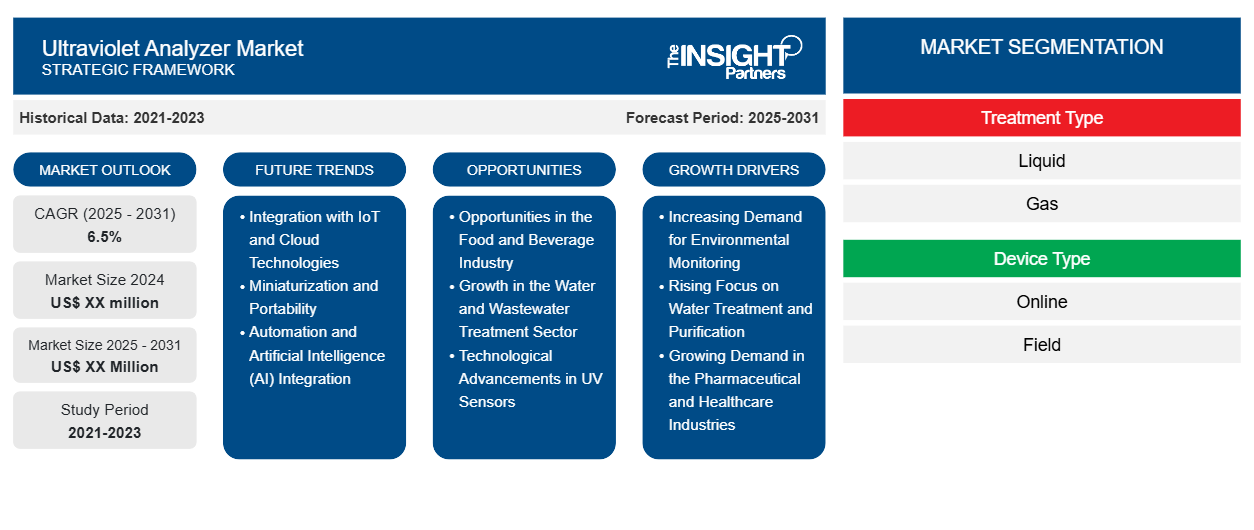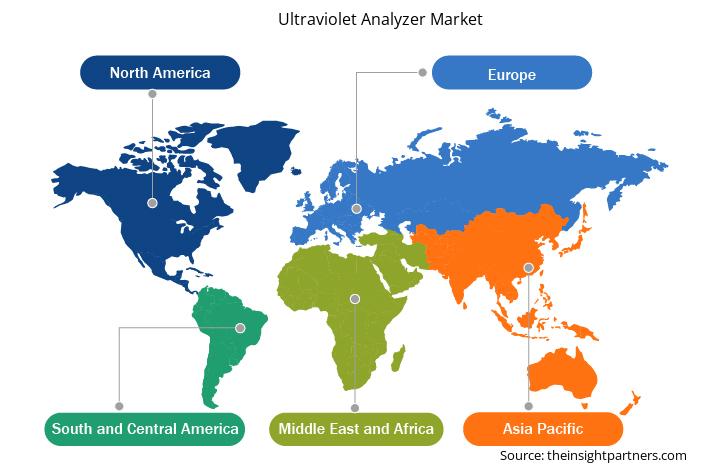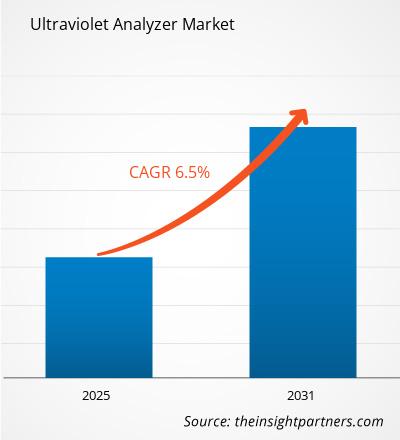预计紫外线分析仪市场在 2025 年至 2031 年期间的复合年增长率为 6.5%,市场规模将从 2024 年的 XX 百万美元扩大到 2031 年的 XX 百万美元。
本报告按处理类型(液体、气体)、设备类型(在线、现场)、行业(石油和天然气、化学品和制药、环境、食品和饮料、其他)进行细分。全球分析进一步细分为区域和主要国家。报告以美元为单位,列出了上述分析和细分市场的价值。
报告目的
Insight Partners 发布的《紫外线分析仪市场》报告旨在描述紫外线分析仪市场的现状和未来增长、主要驱动因素、挑战和机遇。该报告将为各业务利益相关者提供洞见,例如:
- 技术提供商/制造商:了解不断变化的市场动态并了解潜在的增长机会,使他们能够做出明智的战略决策。
- 投资者:对市场增长率、市场财务预测以及整个价值链中存在的机会进行全面的趋势分析。
- 监管机构:规范市场政策和警察活动,旨在最大限度地减少滥用行为,维护投资者的信任和信心,维护市场的完整性和稳定性。
紫外线分析仪市场细分
治疗类型
- 液体
- 气体
设备类型
- 在线的
- 场地
行业
- 石油和天然气
- 化学品和制药
- 环境的
- 食品和饮料
地理
- 北美
- 欧洲
- 亚太地区
- 中东和非洲
- 南美洲和中美洲
定制此报告以满足您的要求
您可以免费定制任何报告,包括本报告的部分内容、国家级分析、Excel 数据包,以及为初创企业和大学提供优惠和折扣
紫外线分析仪市场:战略洞察

- 获取此报告的顶级关键市场趋势。此免费样品将包括数据分析,从市场趋势到估计和预测。
紫外线分析仪市场增长动力
- 环境监测需求日益增长:随着人们对空气和水污染的日益关注,环境监测领域对紫外分析仪的需求也日益增长。紫外分析仪广泛用于测量污染物,例如水中的有机化合物,以及空气质量检测,尤其用于检测臭氧和挥发性有机化合物 (VOC)。各国政府和各行各业都将环境保护放在首位,这推动了对紫外分析仪等精确实时监测解决方案的需求。随着全球环境法规的收紧,预计这一趋势将加速发展。
- 水处理和净化日益受到关注:人口增长、工业化和气候变化等因素推动了对清洁安全水的需求不断增长,这是紫外线分析仪市场的重要驱动力。紫外线分析仪用于水处理厂监测和控制消毒过程,确保水符合安全标准。住宅和工业领域越来越多地采用基于紫外线的水处理方法,这为监测和验证水净化系统功效带来了巨大的紫外线分析仪需求。
- 制药和医疗保健行业需求不断增长:紫外分析仪在制药和医疗保健行业中日益广泛地用于质量控制和过程监控。它们用于测定特定化学物质的浓度、评估纯度水平以及确保产品的完整性。随着对高质量和安全药品的需求不断增长,药品生产和检测过程中对紫外分析的需求也日益增长。预计这一趋势将持续下去,尤其是在医疗保健领域对药品安全和监管要求日益关注的背景下。
紫外线分析仪市场未来趋势
- 与物联网和云技术的集成:紫外线分析仪与物联网 (IoT) 和云计算的集成是一个重要趋势。通过将紫外线分析仪连接到支持物联网的平台,企业可以访问来自多个设备的实时数据并远程监控流程。基于云的存储支持长期数据跟踪和预测性维护,从而提高整体系统效率并减少停机时间。随着各行各业寻求更大的灵活性和对监控流程的控制力,这一趋势预计将变得更加普遍。
- 小型化和便携性:小型化趋势也影响着紫外分析仪市场。制造商越来越多地设计紧凑、便携的紫外分析仪,以便在各种环境下轻松使用,例如现场测试和移动应用。这些便携式设备预计将在需要现场测试和快速获得结果的行业(例如环境监测、食品安全和水质检测)中获得青睐。这种便携性趋势使紫外分析仪更易于获取,并适用于各种应用。
- 自动化与人工智能 (AI) 集成:自动化和人工智能技术正日益与紫外分析仪集成,以增强其性能。人工智能驱动的系统可以优化分析流程,提供预测性洞察,并减少人工干预。自动化使紫外分析仪能够进行连续、实时监测,无需手动校准或调整。人工智能还能实时检测异常,提高准确性并加快决策速度。这些趋势将使紫外分析仪在工业和环境应用中更加智能、高效。
紫外线分析仪市场机遇
- 食品饮料行业的机遇:食品饮料行业为紫外分析仪带来了巨大的增长机遇。这些分析仪用于质量控制,检测污染物、监控食品加工过程并确保产品安全。随着消费者对食品安全标准和食品生产透明度的要求越来越高,紫外分析仪可以帮助制造商确保合规性并改进质量保证流程。消费者对更健康、更安全的食品日益增长的需求,将继续推动食品安全应用中对紫外检测方法的需求。
- 水和废水处理行业的增长:水处理行业为紫外分析仪市场提供了巨大的机遇。随着全球水资源短缺和水质问题的持续存在,市政当局和各行各业正在采用基于紫外的水处理方法来净化饮用水和处理废水。紫外分析仪在确保水处理过程有效运行、监测消毒效率和验证水质方面发挥着至关重要的作用。水基础设施投资的不断增加以及向可持续水管理实践的转变,为该行业带来了巨大的增长机会。
- 紫外线传感器的技术进步:紫外线传感器技术的持续进步为市场带来了巨大的机遇。更灵敏、更精确、更耐用的紫外线传感器的开发将提升紫外线分析仪的性能,扩大其在各个行业的适用性。例如,新的传感器技术可以使紫外线分析仪能够更精确地检测更广泛的化合物、污染物和污染物,从而推动对这些设备的需求。这一进步在环境监测、医疗保健和制药等领域尤为重要。
紫外线分析仪市场区域洞察
Insight Partners 的分析师已详尽阐述了预测期内影响紫外线分析仪市场的区域趋势和因素。本节还讨论了北美、欧洲、亚太地区、中东和非洲以及南美和中美洲的紫外线分析仪市场细分和地域分布。

- 获取紫外线分析仪市场的区域具体数据
紫外线分析仪市场报告范围
| 报告属性 | 细节 |
|---|---|
| 2024年的市场规模 | XX百万美元 |
| 2031年的市场规模 | XX百万美元 |
| 全球复合年增长率(2025-2031) | 6.5% |
| 史料 | 2021-2023 |
| 预测期 | 2025-2031 |
| 涵盖的领域 | 按治疗类型
|
| 覆盖地区和国家 | 北美
|
| 市场领导者和主要公司简介 |
|
紫外线分析仪市场参与者密度:了解其对业务动态的影响
紫外线分析仪市场正在快速增长,这得益于终端用户需求的不断增长,而这些需求的驱动因素包括消费者偏好的不断变化、技术进步以及对产品优势的认知度不断提高。随着需求的增长,企业正在扩展产品线,不断创新以满足消费者需求,并抓住新兴趋势,从而进一步推动市场增长。
市场参与者密度是指特定市场或行业内企业或公司的分布情况。它表明特定市场空间内竞争对手(市场参与者)的数量相对于其规模或总市值而言。
紫外线分析仪市场的主要公司有:
- ABB有限公司
- 阿美特克公司
- 艾默生电气公司
- 堀场制作所有限公司
- 泰莱达因分析仪器公司
免责声明:以上列出的公司没有按照任何特定顺序排列。

- 获取紫外线分析仪市场顶级关键参与者概览
主要卖点
- 全面覆盖:该报告全面涵盖了紫外线分析仪市场的产品、服务、类型和最终用户的分析,提供了整体概况。
- 专家分析:本报告基于对行业专家和分析师的深入了解而编写。
- 最新信息:该报告涵盖了最新信息和数据趋势,确保了业务相关性。
- 定制选项:此报告可以定制以满足特定客户要求并适合业务策略。
因此,这份关于紫外线分析仪市场的研究报告有助于引领解读和理解行业现状及增长前景。尽管存在一些合理的担忧,但本报告的总体优势往往大于劣势。
- 历史分析(2 年)、基准年、预测(7 年)及复合年增长率
- PEST和SWOT分析
- 市场规模、价值/数量 - 全球、区域、国家
- 行业和竞争格局
- Excel 数据集
近期报告
相关报告
客户评价
购买理由
- 明智的决策
- 了解市场动态
- 竞争分析
- 客户洞察
- 市场预测
- 风险规避
- 战略规划
- 投资论证
- 识别新兴市场
- 优化营销策略
- 提升运营效率
- 顺应监管趋势




















 获取免费样品 - 紫外线分析仪市场
获取免费样品 - 紫外线分析仪市场